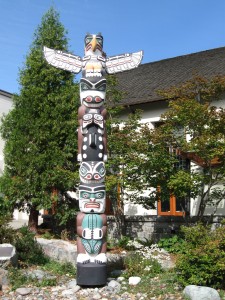Throughout this course I have repeatedly come back to thinking about the Knowing the Land Beneath Our Feet Indigenous walking tour in UBC, which I got to try out as part of Daniel Justice’s FNIS 100 class last year. In this blog post I will contend, through our class reading ‘Mediacosmology’ by Steven Loft from Coded Territories, that the method of a digital walking tour is continuous with the storytelling method used in the Victory Through Honour totem pole outside of Brock Hall, which is one of the sites in the tour. The sharing of Indigenous presence at this site which thousands of students flood past each day powerfully asserts that Indigenous people have not gone away, and that their stories are recorded in various ways across the land that force us to consider the implications of our presence on traditional, ancestral, unceded territory.
Here is a brief introduction to the Knowing the Land Beneath Our Feet project, for those who are not familiar with it:

Steven Loft fundamentally argues in ‘Mediacosmology’ that the way Indigenous peoples have always used objects to ‘memorialize the “peoples” in a non-linear, user-generated … way’ is very similar to how the internet and other digital media tools are used today to convey narratives (173). Loft even says that ‘[c]yberspace connects the past to the present and the spiritual to the material in ways that would make our elders laugh’ (175). This connection between the past and the present which Loft describes is similarly behind the concept of the walking tour, as individuals learn stories while physically occupying the land where they were born. Understanding cyberspace as continuous with Indigenous ways of representing information opens up a connection between the act of a student standing in front of the totem pole with their smartphone, reading and watching a video about it, and the pole’s own representation of stories that are important to Kwakwaka’wakw carver Ellen Neel’s community.
At this site in Knowing the Land, the smartphone and the totem pole work harmoniously to draw connections between the fact of prior occupation of what is now UBC campus and each visitor’s current occupation of that same land. As the past and the present meet through a method which is continuous with how Indigenous peoples have always understood such connections, the project’s goal of fostering an understanding of why we must know the land can be effectively realised.
David Gaertner
December 14, 2015 — 11:49 pm
Fascinating application of Loft to the KLBF project, Louise. You’ve given me lots to think about! I agree that there is more to be said about the ways in which new media (perhaps paradoxically) connects users to traditional storytelling practices. If apps like KLBF are to succeed, they (we) are going to need to more adequately theorize/apply this potential.